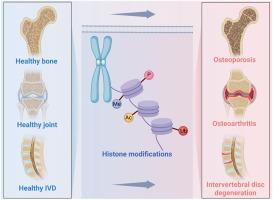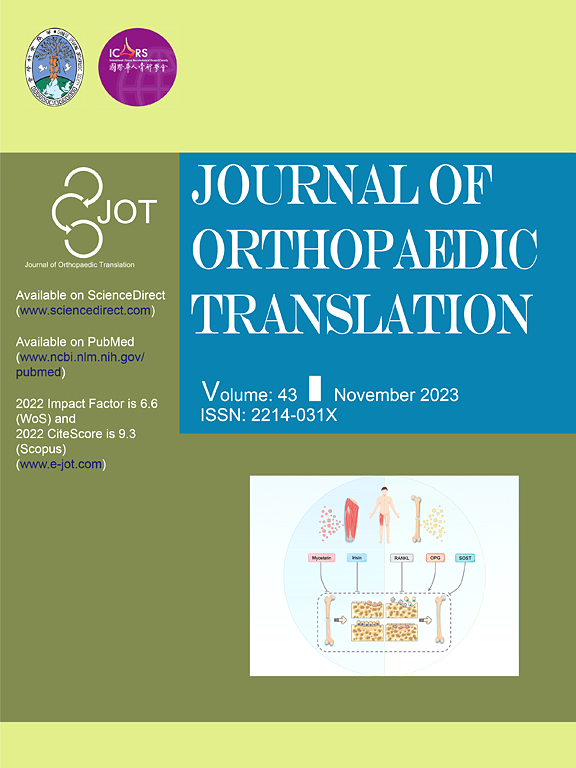组蛋白修饰:揭示退行性骨骼疾病的表观遗传谜团
IF 5.9
1区 医学
Q1 ORTHOPEDICS
引用次数: 0
摘要
退行性骨骼疾病,包括骨质疏松症、骨关节炎和椎间盘退变,是常见的与年龄相关的疾病,其特征是进行性组织变性和功能下降。组蛋白修饰是组蛋白残基共价修饰,由特定酶催化,可调节染色质结构和转录活性。越来越多的证据强调了组蛋白修饰在协调疾病相关转录程序中的关键作用。在骨质疏松症中,组蛋白修饰调节成骨细胞和破骨细胞的分化,从而破坏骨稳态。在骨关节炎中,它们驱动软骨细胞中基质降解酶的表达,促进软骨降解。在椎间盘退变中,它们与髓核细胞衰老、细胞凋亡和细胞外基质降解有关。这篇综述总结了组蛋白修饰在这些疾病中的独特机制作用,并探讨了靶向组蛋白修饰酶的治疗潜力,强调表观遗传调控是精确干预退行性骨骼疾病的一种有前途的策略。本文的翻译潜力:本文全面探讨了组蛋白修饰在退行性骨骼疾病中的作用,并评估了组蛋白修饰酶抑制剂作为治疗靶点的潜力。这些见解为退行性骨骼疾病的治疗提供了新的策略和方向。本文章由计算机程序翻译,如有差异,请以英文原文为准。

Histone modifications: Unveiling the epigenetic enigma of degenerative skeletal diseases
Degenerative skeletal diseases, including osteoporosis, osteoarthritis, and intervertebral disc degeneration, are prevalent age-related conditions characterized by progressive tissue degeneration and functional decline. Histone modifications are covalent modifications of histone residues, catalyzed by specific enzymes, that modulate chromatin architecture and transcriptional activity. Accumulating evidence highlights the critical involvement of histone modifications in orchestrating disease-associated transcriptional programs. In osteoporosis, histone modifications regulate osteoblast and osteoclast differentiation, thereby disrupting bone homeostasis. In osteoarthritis, they drive the expression of matrix-degrading enzymes in chondrocytes, contributing to cartilage degradation. In intervertebral disc degeneration, they are implicated in nucleus pulposus cell senescence, apoptosis, and extracellular matrix degradation. This review summarizes the distinct mechanistic roles of histone modifications across these conditions and explores the therapeutic potential of targeting histone-modifying enzymes, underscoring epigenetic regulation as a promising strategy for precision intervention in degenerative skeletal diseases.
The translational potential of this article: This review comprehensively explores the role of histone modifications in degenerative skeletal diseases and evaluates the potential of histone-modifying enzyme inhibitors as therapeutic targets. These insights provide new strategies and directions for the treatment of degenerative skeletal diseases.
求助全文
通过发布文献求助,成功后即可免费获取论文全文。
去求助
来源期刊

Journal of Orthopaedic Translation
Medicine-Orthopedics and Sports Medicine
CiteScore
11.80
自引率
13.60%
发文量
91
审稿时长
29 days
期刊介绍:
The Journal of Orthopaedic Translation (JOT) is the official peer-reviewed, open access journal of the Chinese Speaking Orthopaedic Society (CSOS) and the International Chinese Musculoskeletal Research Society (ICMRS). It is published quarterly, in January, April, July and October, by Elsevier.
 求助内容:
求助内容: 应助结果提醒方式:
应助结果提醒方式:


